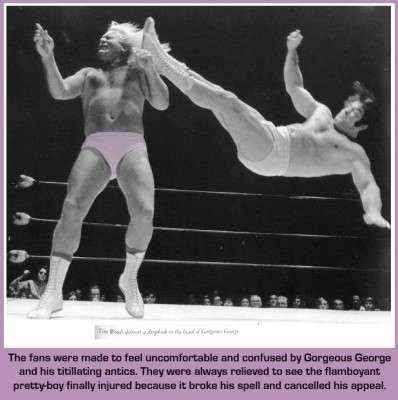 Since the days of Gorgeous George, the flamboyant blond wrestler has been a common villain in pro wrestling. A hated rule-breaker, the Hollywood Blond is always arrogant, flirtatious, and wears expensive flashy gear. He is emotional and whiny, and uses dirty tactics such as biting or pulling hair to win. He looks down on common, ugly, non-fabulous schmucks like you and me. So why does this flamboyant gender-bending bad boy tend to both repel and excite the fans?
Since the days of Gorgeous George, the flamboyant blond wrestler has been a common villain in pro wrestling. A hated rule-breaker, the Hollywood Blond is always arrogant, flirtatious, and wears expensive flashy gear. He is emotional and whiny, and uses dirty tactics such as biting or pulling hair to win. He looks down on common, ugly, non-fabulous schmucks like you and me. So why does this flamboyant gender-bending bad boy tend to both repel and excite the fans?
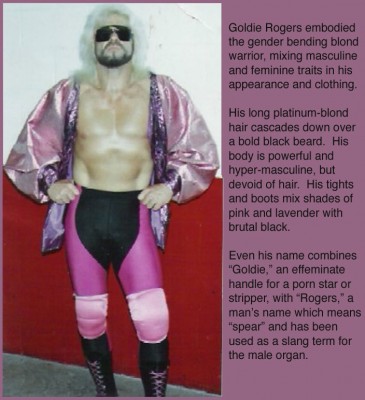 The blond warrior forces us to re-examine our definition of masculinity. Society expects an athlete to be the strong silent type: a man of action, no-frills, hard working, stoic, and honest. The blond bombers that invaded the ring after World War II, however, were shocking to the fans because they were evil “bitches” who could also hurt an opponent — sneaky, selfish, flirtatious, but also fierce and talented. These brutal Nancy-Boys challenged our definition of “manly” while offending us with their cruel and effeminate tactics in the ring.
The blond warrior forces us to re-examine our definition of masculinity. Society expects an athlete to be the strong silent type: a man of action, no-frills, hard working, stoic, and honest. The blond bombers that invaded the ring after World War II, however, were shocking to the fans because they were evil “bitches” who could also hurt an opponent — sneaky, selfish, flirtatious, but also fierce and talented. These brutal Nancy-Boys challenged our definition of “manly” while offending us with their cruel and effeminate tactics in the ring.
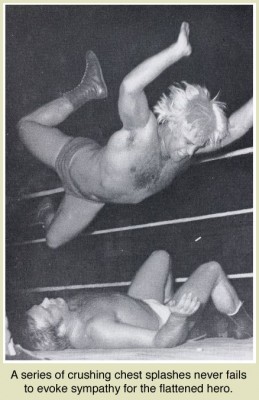 Pro wrestling tells its stories through contrasts, so the effeminate looking blondie is often matched against a manly opponent — a hard-working, blue-collar Good Guy whose sexuality is straight-forward, and who you can be sure would never bend the rules (either in the ring, or in the bedroom.)
Pro wrestling tells its stories through contrasts, so the effeminate looking blondie is often matched against a manly opponent — a hard-working, blue-collar Good Guy whose sexuality is straight-forward, and who you can be sure would never bend the rules (either in the ring, or in the bedroom.)
Even as a youngster — fascinated but a bit perplexed by the action and pageantry of pro wrestling — I was already indoctrinated with gender roles and believed that the tougher looking guy ought to defeat a wrestler who appeared and acted like a girl. But inevitably, the blond sissy would dominate the match, and I was left feeling that something wasn’t right with this picture — something was off with the universe or my understanding of it.
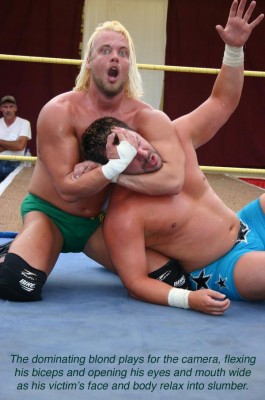 I think the bleached blond wrestler has been a successful trope because he establishes a love-hate relationship with the male viewer, and therefore creates tension and excitement. The pretty-boy is attractive in a feminine way, with his flowing locks of golden hair, shiny gear, and comical flirty antics — shaking his hips and flexing his muscles to attract the male gaze (which is the traditional role of the female.) Some men in the audience find themselves amused by, or even drawn to, his antics — perhaps shocked by their lustful thoughts. They begin to question their masculinity and wonder if the sissy is teasing them or toying with them. This creates a feeling of guilt and disgust — and a delicious sexual tension that brings the viewer back week after week for more.
I think the bleached blond wrestler has been a successful trope because he establishes a love-hate relationship with the male viewer, and therefore creates tension and excitement. The pretty-boy is attractive in a feminine way, with his flowing locks of golden hair, shiny gear, and comical flirty antics — shaking his hips and flexing his muscles to attract the male gaze (which is the traditional role of the female.) Some men in the audience find themselves amused by, or even drawn to, his antics — perhaps shocked by their lustful thoughts. They begin to question their masculinity and wonder if the sissy is teasing them or toying with them. This creates a feeling of guilt and disgust — and a delicious sexual tension that brings the viewer back week after week for more.
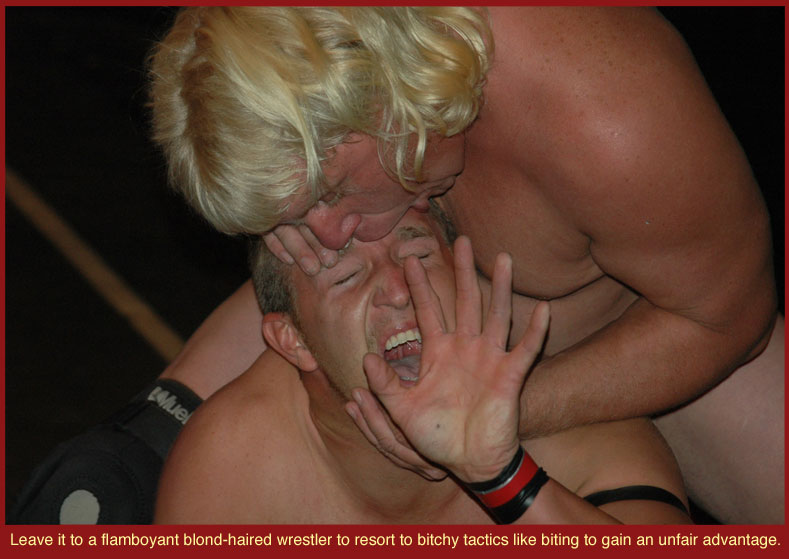 It really is an unusual look for a man: long hair bleached so blond, it becomes snow white. Not many regular every-day dudes would attempt this hairstyle, but it’s been very common in pro wrestling. It’s almost like the long white wigs that British judges wear as the traditional symbol of their profession.
It really is an unusual look for a man: long hair bleached so blond, it becomes snow white. Not many regular every-day dudes would attempt this hairstyle, but it’s been very common in pro wrestling. It’s almost like the long white wigs that British judges wear as the traditional symbol of their profession.
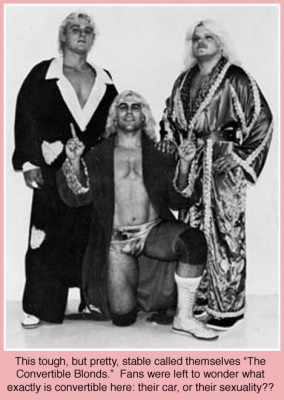 Another reason the blond sissy was so popular during the second half of the 20th century was that the Feminist movement was gaining traction. More women were entering the workplace, and traditional male and female roles were being questioned and re-defined in those days. Men were soon being emasculated in the media, forced to pander to women in relationships, and passed over for promotions at work by strong women.
Another reason the blond sissy was so popular during the second half of the 20th century was that the Feminist movement was gaining traction. More women were entering the workplace, and traditional male and female roles were being questioned and re-defined in those days. Men were soon being emasculated in the media, forced to pander to women in relationships, and passed over for promotions at work by strong women.
As females began taking on traditionally male roles (boss, bread-winner, soldier), men were sissified and began toying with feminine attributes (acting pretty, flirty, emotional.) Pro wrestling, as always, hyperbolized the issue and threw it right in our faces, by creating outrageous blond sissies who were practically drag queens.
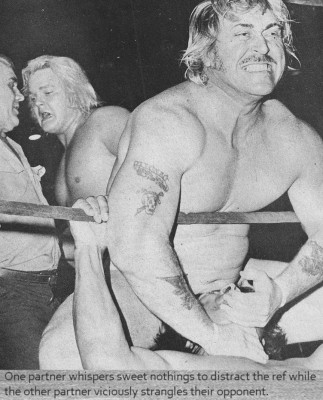 The “bitch” wrestler would usually fight like a girl, scratching, biting, and pulling hair to subjugate and dominate the Real Man opponent. The take-away for male viewers is that the sissified fighter, who represents a female, is nasty and under-handed just like a woman. Femininity is portrayed as “bad” or devious.
The “bitch” wrestler would usually fight like a girl, scratching, biting, and pulling hair to subjugate and dominate the Real Man opponent. The take-away for male viewers is that the sissified fighter, who represents a female, is nasty and under-handed just like a woman. Femininity is portrayed as “bad” or devious.
The male wrestler (whom the male fan identifies with) is made to suffer by the sadistic “bitch”, but remains fair and virtuous. Men may be losing our dominant role in society, the wrestling fan reassures himself, but at least Real Men fight clean and honest.
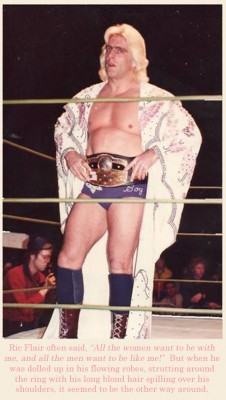 As women were finding success in business and politics in the 70’s and 80’s, pretty blond wrestlers were winning championship belts (albeit through nasty, illegal tactics.) This symbolized the ascent of femininity. But notice how they never portrayed a true woman as the World’s Champ, instead placing a feminized blond male in the dominant role.
As women were finding success in business and politics in the 70’s and 80’s, pretty blond wrestlers were winning championship belts (albeit through nasty, illegal tactics.) This symbolized the ascent of femininity. But notice how they never portrayed a true woman as the World’s Champ, instead placing a feminized blond male in the dominant role.
Similar to the ban against women performing as actors in Elizabethan days (go watch Shakespeare in Love), pro wrestling today doesn’t permit women to be seen out-wrestling or defeating a male Champion.
The message that pro wrestling sends is that, in the end, despite all the strides women have made, the male fans can rest assured that men (including pretty men) remain dominant in at least one place: the wrestling ring.
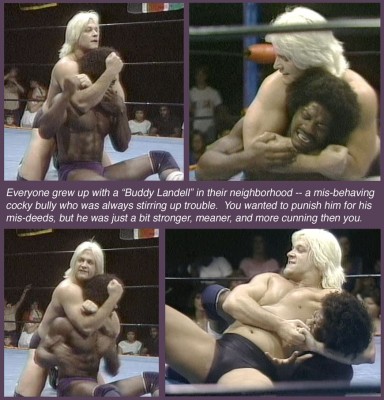 Ironically, the flamboyant blond actually re-affirms male domination and further subjugates females. This is because he is able to safely co-opt feminine traits at will, on his own terms, for his own pleasure and glorification. He remains masculine and strong (a champion) through his wrestling prowess and ability to inflict pain, but can also be beautiful.
Ironically, the flamboyant blond actually re-affirms male domination and further subjugates females. This is because he is able to safely co-opt feminine traits at will, on his own terms, for his own pleasure and glorification. He remains masculine and strong (a champion) through his wrestling prowess and ability to inflict pain, but can also be beautiful.
The message being sent is that a Real Man can be King and Queen. We don’t need women in the ring if we have effeminate blond males to play that role.
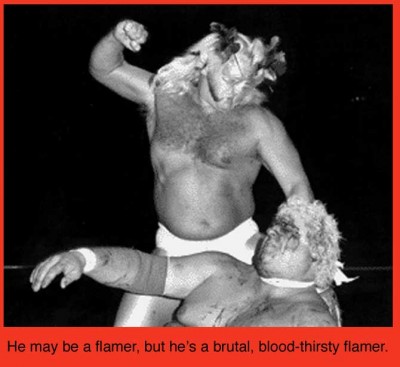 The blond wrestler avoids the threat of feminine power by co-opting and incorporating female traits into his persona alongside his undeniable male traits. Note that his drag costume is always incomplete. His muscles can’t be hidden. His costumes are more garish than beautiful. He often keeps a dark beard or hairy chest so he remains clearly identified as a male, albeit a gorgeous, flowery male.
The blond wrestler avoids the threat of feminine power by co-opting and incorporating female traits into his persona alongside his undeniable male traits. Note that his drag costume is always incomplete. His muscles can’t be hidden. His costumes are more garish than beautiful. He often keeps a dark beard or hairy chest so he remains clearly identified as a male, albeit a gorgeous, flowery male.
In the end, the flamboyant blond wrestler is used to mock and lampoon both the macho men and sissy-boys in our society, while reminding us that gender roles are really just another silly performance that we all act out.
